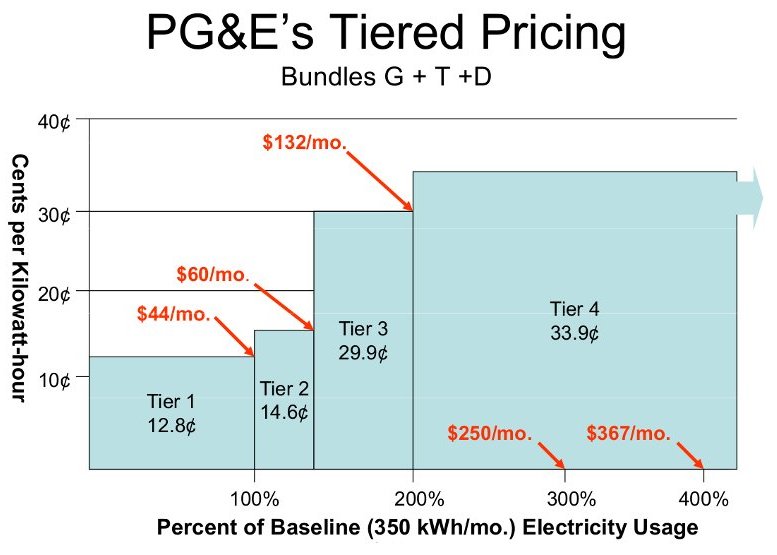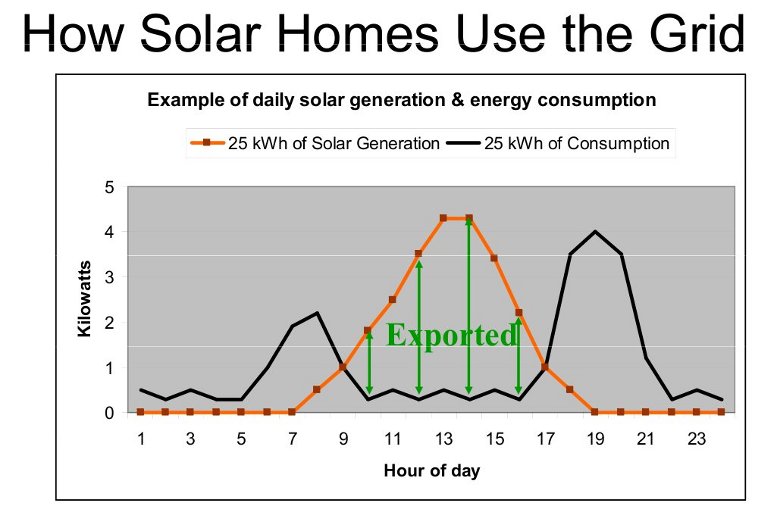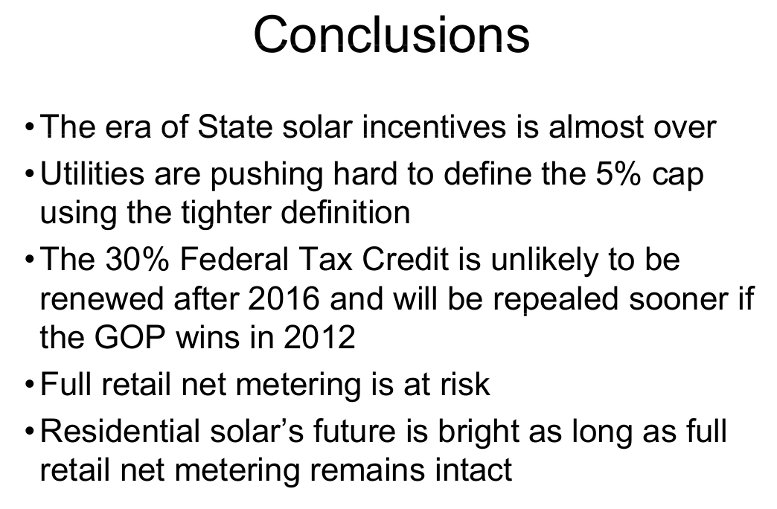>
> Bruce Karney
>
> The Future of Solar Energy Incentives in California
>
>
> California’s movement toward a renewable energy future has been
> accelerated by government subsidies for solar-produced
electricity,
> notably the California Solar Initiative’s (CSI) Million Solar
Roofs
> Program. The Million Solar Roofs Program launched in 2007
with the goal
> of stimulating the installation of 3,000 megawatts of new solar
power
> systems by 2016.
>
> Subsidies were initially set at $2,500 per AC kilowatt or 39 cents
per
> kWh produced in the first 5 years. That covered about 20% of
the cost
> of a system, and federal tax credits paid for another 30%. The
incentive
> program was designed so that the incentives would reduce in steps
over
> the 10 years of the CSI. These reductions have taken place
somewhat
> faster than expected. The incentive is now $250 per AC
kilowatt in PG&E
> territory.
>
> As the CSI program approaches its end and other programs such as
net
> metering are facing scrutiny from utilities, there is concern from
> environmental organizations and solar equipment makers that
California’s
> movement toward a cleaner energy future may stall.
Experience in other
> countries has shown that poorly designed and administered
incentives and
> requirements can produce a boom and bust cycle in the solar
business.
>
> Bruce Karney has been involved in solar photovoltaics since he
organized
> a group purchase of solar panels in 2007 in which 119 Mountain
View
> homeowners bought solar PV from a single vendor at a deep
discount.
> Since then he has worked in marketing and customer finance at
SolarCity,
> California's leading residential solar design, installation and
> financing company. He is currently Marketing Operations
Manager at
> Skyline Solar, a Mountain View based manufacturer of
> medium-concentration photovoltaic systems. Bruce will review
the state
> of solar subsidies in California and elsewhere and offer his
thoughts on
> what the future may hold.
>
Bruce began by breaking the role of
government in solar pricing over time into three eras. The first was
the era of carrots, the second the era of sticks, and the third will be
the era of market forces. The era of carrots was started back in the
1970s, when government instituted subsidies to jump start the industry.
This era is expected to end in 2013. The second era is the era of
sticks, when regulations require a certain percentage of renewables in
utility portfolios. The third era is going to be the era of market
forces, when supply and demand will meet in the marketplace at a price
set by negotiation.
Carrots usually take the form of tax credits or rebates. For example,
when Bruce got together a solar buying club in 2007 there was a
$2,500/kilowatt incentive from the State of California (part of the
Million Solar Roofs program). In addition, the U.S. Govt. offered tax
credits for such systems that lowered the cost by $2000. The CSI
program will end in 2013 in PG&E territory, and it is unlikely to
be renewed. The explosive growth of solar panel supply, coupled with a
slowing of the growth of demand, caused solar panel prices to fall by
50% last year and price reductions are expected to continue in 2012-13,
though at a much slower pace.
Sticks are expected to take the form of
portfolio resupply and demand are not adjusted by government
regulations. In such
an environment, for renewable energy For example, PG&E is expected
quirements. For example, PG&E is expected to provide
25% renewables by 2016 and 33% renewables by 2020. Because utilities
have found that people get much more angry when the power goes out than
they do when the price goes up, it is expected that price signals
(higher utility bills) will be a key part of adjusting power demand so
that the available renewable supply will be the mandated percentage of
total power generation.
Market forces determine price when the
supply and demand are not adjusted by government regulations. In such
an environment, for renewable energy For example, PG&E is expected
to provide 25% renewables by 2016 and 33% renewables by 2020.to succeed
it must be cheaper on a per kW/Hr basis than the same amount of coal
based power. Currently that price is about six cents per kilowatt-hour.
Bruce explained how market forces work with the following graph of
California's power pricing by our largest utility.

Customers who spend more than
$132/Month on power are paying 33.9 cents per kWh for some of their
power. It is a no brainer to install solar systems that supply that
percentage of the load. Many, many people and companies have done so.
If Texas had a pricing policy like this one, they would have much more
installed solar than they do. Texas is hot compared to California.
Since every kWh used there costs the same coming out of the plug there
people have no incentive to conserve the way we do here.

Solar systems come in a variety of
configurations. The most cost effective is a grid tied system, using
the power grid as a battery. The way that works is that the system
pumps energy into the grid during the day, when the sun is shining.
(That's the green area on the chart.) This works out well for the
utility, since most of their peak demand comes during the day. Then at
night the system absorbs power from the grid. A properly sized system
will balance out supply and demand, so that at the end of the year the
net cost to the owner is low.
For years and years the government has
set the percentage of the power portfolio that can be supplied by
solar. At first it was 1%, then later 2%. Now it is up to 5%, but the
utilities are haggling with the incumbents over what that means. Five
percent of total possible supply? Five percent of a normal days supply?
The differences between these numbers are large enough that the
lobbyists are investing a lot in the discussion.
During Q&A a number of interesting points came up:
If your power bill is in the $100-$150
per month range, a solar system would cost you about $8000 to install,
and will pay for itself in about five to eight years.
No new Municipal Utility Districts have
been started in California recently, although Marin County and San
Francisco are at least talking about it.
If you want to get rid of First Solar
panels, just call up the company and they will come get them. This is
partly because they contain Cadmium and Tellurium, toxic metals. Most
solar panels contain a bit of silver. Maybe you could get a few cents
from scraping it off. In most systems the power inverter fails before
the panels, which amounts to a roll-on suitcase sized ewaste pill when
it's replaced. The solar panels themselves can last many years.
Solar policy positions aren't enough by
themselves to decide which Presidential candidate to vote for, but
clearly Obama's solar policies are better than Romney's.



